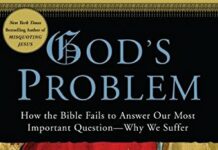
Ebook Info
- Published: 1999
- Number of pages: 288 pages
- Format: PDF
- File Size: 14.10 MB
- Authors: Bart D. Ehrman
Description
In this highly accessible discussion, Bart Ehrman examines the most recent textual and archaeological sources for the life of Jesus, along with the history of first-century Palestine, drawing a fascinating portrait of the man and his teachings.Ehrman shows us what historians have long known about the Gospels and the man who stands behind them. Through a careful evaluation of the New Testament (and other surviving sources, including the more recently discovered Gospels of Thomas and Peter), Ehrman proposes that Jesus can be best understood as an apocalyptic prophet–a man convinced that the world would end dramatically within the lifetime of his apostles and that a new kingdom would be created on earth. According to Ehrman, Jesus’ belief in a coming apocalypse and his expectation of an utter reversal in the world’s social organization not only underscores the radicalism of his teachings but also sheds light on both the appeal of his message to society’s outcasts and the threat he posed to Jerusalem’s established leadership.
User’s Reviews
Reviews from Amazon users which were colected at the time this book was published on the website:
⭐This is not the end of your faith… at least not necessarily. In two key books, Apocalyptic Prophet (about the historic Jesus) and Misquoting Jesus (about the New Testament), Dr. Ehrman searches the most reliably accurate parts of the gospels to better understand who Jesus was. From this effort, Ehrman makes an exceedingly strong case that Jesus was a human product of his time, not of All Time.This is hard reading for Christians because Ehrman, formerly a Christian, methodically examines other historical sources along with the oldest surviving materials of the New Testament to make informed, rational, evidence-based arguments consistent with proven principles of scholarship. He’s not pulling this stuff out of the air — in fact, much of it has been long-proved but ignored — and he’s well aware of the crisis this awareness can cause. But evidence in the text and subtext of Jesus’ message shows that Jesus’ life was altogether human. His story, however, made a compelling impression that took on a life of its own almost immediately. Ehrman traces where emphases, errors and additions were made to the Jesus story from the start, possibly while he was still alive. (Possibly, even by him.)But it became a powerful story, one that his followers couldn’t let go of. Many of us still can’t.Ehrman’s point is that the actual Yeshua from Nazareth, however, was simply not the character that emerged through First Century fan fiction. We don’t know a lot about that former “Jesus,” the actual person. But the latter legendary Jesus stood the test of time because, for good and for ill, the canonical gospels allowed believers from different times, cultures and contexts to emphasize those parts of the official story that they most craved. And even with all the tampering the story received as a result, some of the underlying ideas communicated by the mortal Yeshua from Nazareth gave us a lot to work with over the last twenty centuries. The world was sorely ready for that man’s radical ethical message — all the more contagious because he mixed it with an equally radical license of apocalyptic urgency. It was a powerful combination, but flawed. The actual Yeshua believed that the world, a mistakenly tiny world, was about to end in a spectacle of doom and magic. He wasn’t the first cultural prophet to bet his life on such beliefs, and to be wrong. We know now that history wasn’t over. He was in fact writing history, in ways he never imagined.So the personal question Christians are left with after considering Ehrman’s work is: What do we do with God, without Jesus as God? For some, faith dies without religion. Ehrman went from being an evangelical fundamentalist ‘Bible college’ Christian to a moderate, literate Christian, and ultimately an agnostic heavily influenced by the New Atheism. He had very good reasons for this, and his journey was painful and real. But the same route isn’t for everyone.The truth is, if you’re a Christian who has seriously read Ehrman’s work then you’ve already crossed the Rubicon into literate faith. Literal faith is over for you, whether you recognize it or not. You probably don’t need a textual historian to convince you that Earth is more than 5700 years old, that theocracy is disastrous, that the Left Behind series is reckless huxterism. You may have already come to the conclusion that God wants you to be rational and intellectually honest, and that loving God — however less certainly you view God now — involves doing so with the mind you were given. Sometimes faith dies. But as the Jesus legend demonstrates, sometimes that’s also how we experience faith anew. It’s possible that Ehrman’s theses have been on your spiritual reading list all along; that it’s your time to encounter these facts about the faith, and to be further changed into the thinking spiritual person you’re meant to be.If so, welcome again to the Emmaus Road, where God no longer has the face you knew. For what it’s worth, you’re not traveling alone.
⭐What does history tell us about who Jesus was? New Testament scholar Bart Ehrman has a simple thesis:Jesus is best understood as a first-century Jewish apocalypticist who expected an apocalyptic climax to the history of the world within his generation.On the other hand, Zealot: The Life & Times of Jesus of Nazareth by Reza Aslan (2013, Random House) is the first book about Jesus to be number 1 on the New York Times bestseller list. Aslan’s thesis is that Jesus was a “zealous revolutionary,” who necessarily advocated insurrection. Ehrman contends that Jesus was a pacifist who predicted that God would soon intervene and overthrow the Romans.Ehrman defines his terms. In brief, apocalpticism is the doctrine that “God was soon going to intervene in the affairs of this world, overthrow the forces of evil in a cosmic act of judgment,destroy huge masses of humanity, and abolish existing human political and religious institutions.” This would be a prelude to the arrival of a new order on earth, the Kingdom of God.This worldview emerged among many Jews in first-century Palestine as they suffered under foreign domination and struggled to make sense of why God had not liberated them. They blamed Satan, seeing the world as a clash between good and evil. In the short-term, before God intervenes, things will get worse.Ehrman walks readers through the historical evidence. The information about Jesus from non-Christian sources is sparse. The best evidence is the four gospels, though they must be used with care by applying historical criteria to identify which stories have more credibility than others. On problem for historians is when gospels give conflicting accounts of events such as the birth narrative, the day of crucifixion, and the discovery of the empty tomb.Ehrman points out that none of the gospels claim to be written by an eyewitness.Jesuś’ baptism by the apocalypticist John was consistent with Jesus being an apocalypticist. Jesus spoke highly of John, calling him the greatest man ever to live. (Matt. 11:11) Jesus and his followers started baptizing others. (John 3:22).The first words attributed to Jesus are in Mark 1:15:“The time is fulfilled (filled up), and the kingdom of God has come near; repent, and believe in the good news.”This reflects his apocalyp-ticism, explains Ehrman, the notion that there are two ages, and the first is almost over, so people must repent while there’s still time.Jesus repeately talks about the coming judgment by the Son of Man: Mark 8:38; Mark 13:24–27; Luke 17:24; 26–27, 30; cf. Matt. 24:27, 37–39; Luke 12:8–9; cf. Matt. 10:32–33; Luke 21:34–36; Matt. 13:40–43; Matt. 13:47–50.The term “Son of Man” originates in Daniel 7:2–14 to refer to the one who will rule the earth in an eternal kingdom.The summary of his ethical teaching is that his “followers were to live in ways that prepared for this coming Kingdom and that embodied the values that would be manifest completely and finally when it arrived.” Thus Jesus told his followers to abandon their homes and families to follow him.Jesus expected the new order to happen during the generation of his disciples. “Truly I tell you, some of you standing here will not taste death before they have seen the Kingdom of God having come in power” (Mark 9:1). “Truly I tell you, this generation [i.e., presumably, the one he was addressing] will not pass away before all these things take place”(Mark 13:30).The fact that the second coming was not as imminent as Jesus and Paul believed has not preventedapocalypticism from remaining alive and well. For 2000 years, many if not most Christians have been waiting for God to establish his new order.Being a Christian doomsayer can be a lucrative career. Hal Lindsey’s book, Late Great Planet Earth (1970), wasthe best-selling work of nonfiction of the 1970s with over 28 million copies in print. He predicted Armageddon would occur by about 1988. The Left Behind series consists of 16 books, followed by movies, about the rapture and end times.Ehrman’s theory about Jesus is not new. It was proposed by Albert Schweitzer in The Quest of the Historical Jesus (1906). Ehrman’s book was published in 1999. A book published in 2021 has the same conclusion: Jesus the Apocalyptic Prophet (2021) by Wassen and Hägerland.One note of caution: Christ-followers who embrace history only when it confirms their faith will be disappointed with this book. That’s because some evidence conflicts with their belief that the Bible is the “literal, inspired, inerrant, no- mistakes-of-any-kind and no-historical-problems-whatsoever, absolute words directly from God.” -30-
⭐This is a skim off the surface of some pretty deep waters. But it’s done in such a way that you can see a ways down to where it would lead. Even for lay readers this is easy reading and presented in a friendly, engaging, non scholarly way (no big words). A serious introduction to “the historical Jesus” and a welcome gift to those who would like to know “how it all got started” before the institutional church’s paradigm of atonement theology obscured the apocalyptic Jesus.
⭐I bought this book because the blurb claimed that “through a careful evaluation of the New Testament … Ehrman proposes that Jesus can be best understood as an apocalyptic prophet – a man convinced that the world would end dramatically within the lifetime of his apostles and that a new kingdom would be created on earth”. I was particularly interested in the claim that Jesus was convinced that the world would end “within the lifetime of his apostles”. That he taught that God would intervene in world affairs, overthrow existing kingdoms and establish his own kingdom is self evident even from a cursory reading of the gospels. But what is more contentious is the assertion that he believed all this would happen within the lifetime of his apostles. So if Ehrman was really carrying out a “careful evaluation of the New Testament” I would have expected him to pay close attention to and provide some detailed discussion of the so-called “imminence” passages like Mark 9:1 and Mark 13:30. It comes as a surprise therefore to find that he only has a few short paragraphs in the middle of his book when he simply quotes these verses but provides no analysis of them. There are credible explanations for these verses which show that they do not point to a belief that the universal cosmic intervention of God in human affairs was to take place in Jesus’ generation. (See for example A L Moore’s “The Parousia in the New Testament”. ) Ehrman’s superficial reference to these verses and his failure to interact with alternative explanations means that he has failed to substantiate this crucial part of his thesis and detracts considerably from the value of this book.
⭐I bought this book for my husband who writes: ‘I had heard Ehrman say online that Jesus thought the Son of Man was someone other than himself who would arrive imminently in judgement and salvation. I was curious as to how he would handle those verses which put the Son of Man in the present or past. Eg Mark 2 v10 Mark 2 v28, Mark 10 v45. The answer is, he doesn’t. They are not even in his index. Draw your own conclusions. The three parables in Matthew 24/25 all speak of a delayed not immediate return so the picture is not so clear cut. The Son of Man is a riddle which is not so easily unravelled.’
⭐First up, I am a Christian so obviously read this from a faith aspect, but I have an open mind and indeed I learnt so much and it answered so many queries and anomalies that have always puzzled me. I cannot recommend it enough, and a hard cover to keep is a must if Jesus is high on your agenda – which he is on mine! Well-packaged by the way – arrived on time and just as described.
⭐This review has nothing to do with the actual content of the book. Don’t buy this edition as the font is tiny and even for someone with a good eyesight like myself this edition is very difficult to read. A pity !
⭐Ehrman is always a good read. Thought provoking.
Keywords
Free Download Jesus: Apocalyptic Prophet of the New Millennium 1st Edition in PDF format
Jesus: Apocalyptic Prophet of the New Millennium 1st Edition PDF Free Download
Download Jesus: Apocalyptic Prophet of the New Millennium 1st Edition 1999 PDF Free
Jesus: Apocalyptic Prophet of the New Millennium 1st Edition 1999 PDF Free Download
Download Jesus: Apocalyptic Prophet of the New Millennium 1st Edition PDF
Free Download Ebook Jesus: Apocalyptic Prophet of the New Millennium 1st Edition





